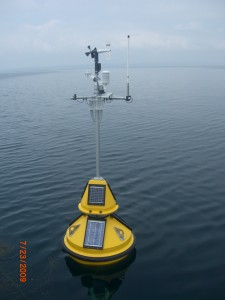By Kimberly Hirai and Sarah Coefield

Researchers position data-collecting buoys in the Great Lakes. Photo courtesy of Guy Meadows.
Editor’s note: This is the fourth in a series of stories on how new technology is giving researchers a glimpse of the critical nearshore area of the Great Lakes
The map is a Battleship board without gridlines.
Red, yellow and blue squares on online maps mark where research scientists Steven Ruberg and Guy Meadows deploy techno-savvy buoys to measure nearshore conditions in the Great Lakes.
“The government buoys that are out in the center of the lake are wonderful, but they don’t tell what’s happening in the coastal zone, and most of the people live and play and work in the coastal zones,” said Meadows, a professor and director of the Marine Hydrodynamics Laboratories at the University of Michigan.
Ruberg is an observing systems researcher at the National Oceanographic and Atmospheric Administration’s Great Lakes Environmental Research Laboratory in Ann Arbor.
Buoys are these scientists’ toy soldiers, strategically positioned to relay nearshore conditions to Web sites.
Nearshore Navigators
The race to provide real-time data about Great Lakes nearshore weather and water conditions is one both scientists have worked on for five years. The goal, Meadows said, is to compile a long-term data set. By characterizing typical conditions, the scientists will be better equipped to predict changes to the ecosystem and water quality.
The scientists’ buoys differ in form more than function. Their equipment measures anything from wave direction and height, air temperature and pressure, windspeed, humidity, water temperature and algae. “We’re essentially providing observations from the surface of the water to the bottom,” Ruberg said.
While Meadow’s buoys are primarily in Grand Traverse Bay and Little Traverse Bay, Ruberg’s fleet spreads across Lakes Michigan, Huron and Erie.
Most are powered by solar panels and chained to a weight. Meadows’ buoys use cell phones to report information to his Web site every six minutes and to the U.S. Government’s National Data Buoy Center, which provides information from buoys around the world.
But buoy wars don’t come without risk of casualties. Ice and winter storms prevent the teams from leaving their buoys out to study lake conditions during the cold months.

The buoys transmit physical, chemical and biological data to shore. Photo courtesy of Guy Meadows.
“The winter season is when the most severe storms are and some of the greatest changes that the lake undergoes are during winter when all that heat that’s been stored up all summer long has dissipated,” Meadows said.
Ice sheets could also move buoys, causing them to take on water. “Biofouling” — the buildup of algae or microbial organisms on buoys and sensors, lightning storms and boat traffic also threaten the technology.
Risks aside, a shot at good data drives scientists to join the buoy arms race. “You can get long-term continuous day and night data sets which are pretty much impossible to obtain by conventional means of humans going out into the lake on a boat,” said Tom Consi, an associate scientist at the Great Lakes Water Institute in Milwaukee. “You just don’t have access to a boat 24 hours a day and a person able to do that kind of sampling or measuring.”
Consi has seven buoys in his Great Lakes Urban Coastal Observing System fleet. Two of the buoys can study chemical, biological and physical lake processes for up to a year while the rest monitor nearshore conditions for weeks at a time. The buoys are designed to study interactions between Milwaukee Harbor and Lake Michigan and radio data back to one of two shore stations. From there, the data reaches the water institute via the Internet.
Public access to online buoy data is in the works.
Meanwhile, Ruberg is looking forward to the day when robots can take over for humans.
“In the long term, what I would like is a mobile buoy that you don’t have a big expensive boat to deploy,” Ruberg said. “You can tell it to go to a location and just sit there and provide observations…many many years from now, that might be what we see.”
Yesterday: Remote-controlled Stealth II reveals nearshore landscape.
Tomorrow: Lake bottom rover must withstand violent conditions while carrying heavy instrument load